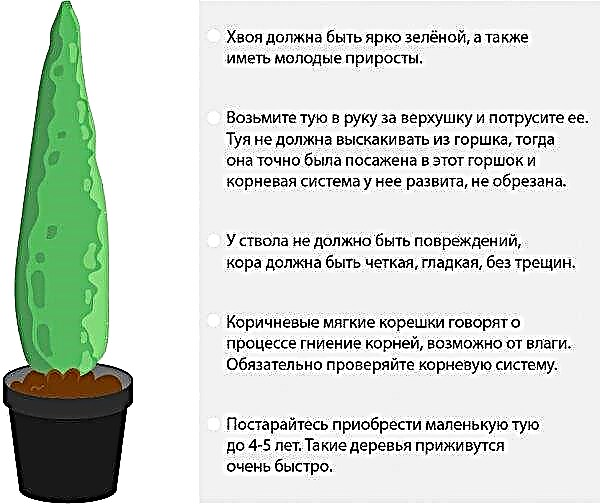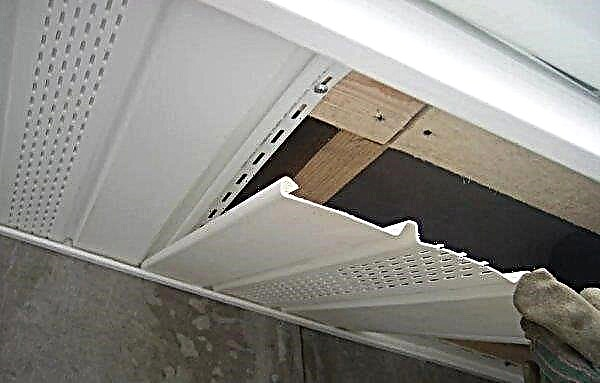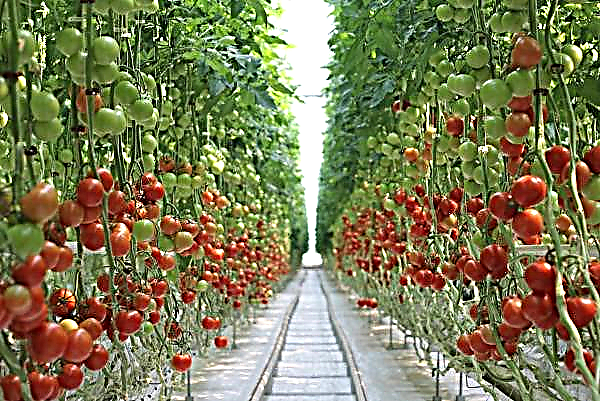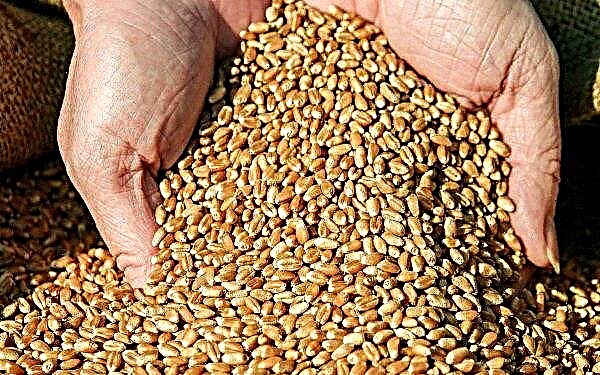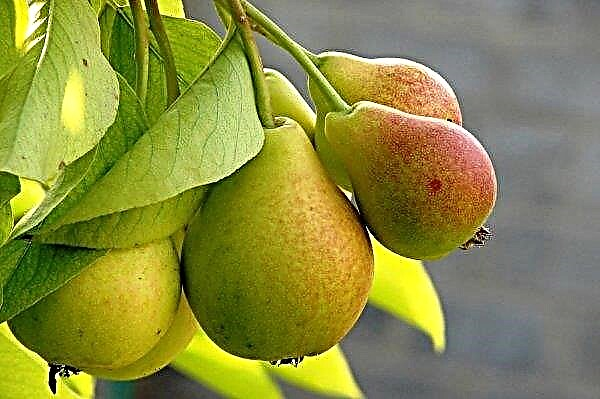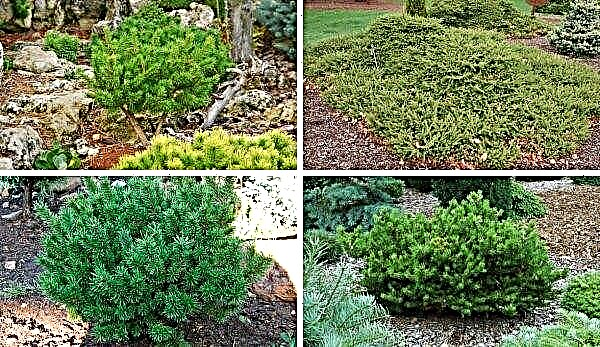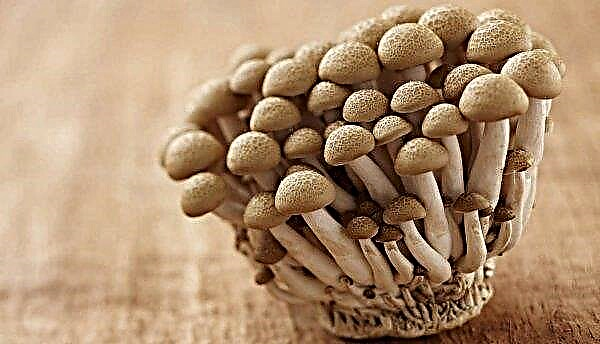One of the most common types of home ornamental plants is dragon dracaena. The shape and arrangement of leaves, it is a bit like a palm tree, so it looks quite exotic in the interior of the room. Consider the main characteristics of dracaena dragon, especially the care and cultivation, as well as possible diseases.
Short description
Dragon dracaena belongs to evergreens. Its homeland is the Canary Islands, where it grows in an arid and hot climate. Indoor dracaena is an ornamental shrub and differs from its "wild" ancestor, so it can be grown at home.
Did you know? There are about 40 types of dracaena. The homeland of most of them is Africa or South Asia.
The main characteristics of dragon dracaena are described below:
- Belongs to the class of monocotyledons.
- Height when grown at home is a maximum of 1.5 m.
- The plant has a gray wood trunk, from which thick branches extend.
- Under natural growing conditions, a flower stalk is formed on the trunk every 10-15 years. After this dragon dracaena begins to produce side branches. They also grow for 10–15 years, and then branch.
- Growth rings on the trunk are absent.
- The trunk contains red resin, reminiscent in color of human blood.
- The leaves are gray in color with a silvery sheen, and are arranged in bunches on the branches. The leaves are 90–110 cm long and 4 cm wide.
- The crown has the shape of a hemisphere and looks like an umbrella.
- Paniculate inflorescences, with many small flowers, are located inside the crown.
- The flowers have a light aroma and resemble lilies, grow in groups of 4-5 pcs. Their color can range from greenish white to light yellow. Usually, dragon dracaena flowers are white.
- On the branches round red fruits are formed with a diameter of up to 1.5 cm. They grow in large clusters.
Photo gallery
Useful properties of dracaena
- Dragon dracaena not only decorates the room, but also has numerous properties useful to humans:
- purifies air, removing about 70% of harmful impurities from it;
- helps to cleanse the body of harmful substances, relieves pain in muscles and bones;
- favorably affects the condition of tooth enamel;
- infusion of dracaena juice with grape alcohol cures stomach ulcers and skin diseases, promotes rapid healing of wounds;
- prevents complications from intestinal diseases;
- improves mood and relieves stress.
Important! Dracaena can not be grown where there are small children or pets. The substance contained in its leaves causes food poisoning.
Growing and caring at home
Indoors, dragon dracaena is usually grown as an ornamental plant. But it grows very slowly and in one decade adds to the height of only 1–1.2 m. Consider the basic rules for its cultivation in room conditions.
Conditions of detention
The homeland of dragon dracaena is hot countries, so its cultivation requires the creation of certain conditions. If you carry out competent plant care, then it will grow over many years. The main attention should be paid to air temperature, irrigation regime and fertilizer application.
Temperature
 The plant is very fond of warmth and bright sun. During the summer heat, they take him outside and put him in a well-lit place.
The plant is very fond of warmth and bright sun. During the summer heat, they take him outside and put him in a well-lit place.
But you can not be in direct sunlight dracene, so as not to provoke the appearance of sunburn.
In winter, it can be kept in a cool room, but always under bright diffused lighting. Air temperature should be from +15 to +20 ° С. For a short time, the plant can even withstand a decrease in air temperature to -5 ° C.
Air humidity
Indoor dracene needs well-moistened air. If the room is too dry and dusty, its leaves begin to dry out. This is why you need to regularly air, and also wipe the leaves from dust. The dragon dracaena should not be placed on a draft, since it can greatly harm it and even provoke the discharge of leaves.
Soil requirements
Dracaena needs loose soil with high air permeability and good drainage. Ideal components in the composition of the soil will be:
- clay;
- sand or fine gravel;
- pumice;
- leaf humus;
- peat.
 All listed components are recommended to be taken in equal proportions. Dracaena grows well in small pots with drainage holes below. If fertilizers are applied on time, it can be in the same soil for several years. As the plants grow older, partial replacement of the soil in the pot can be carried out. To do this, the topsoil is carefully removed and replaced with fresh, heavy earth.
All listed components are recommended to be taken in equal proportions. Dracaena grows well in small pots with drainage holes below. If fertilizers are applied on time, it can be in the same soil for several years. As the plants grow older, partial replacement of the soil in the pot can be carried out. To do this, the topsoil is carefully removed and replaced with fresh, heavy earth.
Did you know? In the wild, the height of the dracaena can be up to 20 m, and the trunk diameter up to 5 m.
Landing
For planting, seeds are usually used bought in a specialized store. Planting technology is simple, but it will take time and proper care for the seeds to sprout.
A step-by-step instruction for planting dragon dracaena seeds is as follows:
- Soak purchased seeds in a solution of growth stimulant. Then gently dry them.
- Prepare a small pot with drainage holes, fill it with earth. The soil needs to be well moistened.
- Submerge the seeds 1 cm deep into the ground.
- Cover the surface of the pot with film, glass or thick paper to create a greenhouse effect.
- Put the pot of seeds in a warm, well-lit place.
- In anticipation of seedlings, the soil in the pot should be regularly watered and aerated. The air temperature in the room should be around +25 ° C.
- After the appearance of green sprouts, they are grown to a height of 5 cm, and then transplanted into permanent pots.
Video: Sowing Dracaena Seeds
Fertilizers and irrigation
In dracaena, the dragon phase of active growth lasts from early spring to early autumn. During this period, she needs a lot of water, but moisture must not be allowed to stagnate around the roots of the plant. To do this, it is recommended to loosen the soil in the pot before watering. In the heat, you can spray the leaves of the plant with water. If brown spots appear on the foliage - this indicates insufficient watering.
If in winter the plant is in a cool room, then it can be watered less often. Spraying with water in the winter can only be done if the room temperature is around +20 ° C.
Dragon dracaena needs nutrients. If it grows in a pot, then fertilizers are applied 2 times a month in the summer and 1 time a month in the winter. Conventional garden fertilizers containing all the necessary nutrients and trace elements are often used as top dressing. In winter, you can not fertilize at all, but only if the room with the plant is cool.Important! For irrigation, use settled or boiled water.
 In open ground, the plant is fed with mineral and organic fertilizers every three months.
In open ground, the plant is fed with mineral and organic fertilizers every three months.Flowering period
Dracaena flowers are very small and do not strike with special beauty. They are revealed only at night to attract the smell of nectar of night insects. The smell of inflorescences is too harsh to be pleasant. At home, dragon dracaena rarely blooms. This only happens with proper care. To do this, you do not need to supercool the plant, periodically moisten the air and soil, make fertilizers.
Pruning
This plant does not require trimming. The removal of stems or leaves is carried out mainly in order to obtain a certain shape of the crown. Dragon dracaena does not like pruning too much. This can not only spoil the appearance of the crown and make it outwardly unattractive, but also harm the plant.
Trimming can be done in two ways:
- Cutting the top for cuttings - a little cut of the stem is made just below the top, into which moist peat is placed and then covered with a bag. After 30 days, young roots begin to grow at the incision site. After that, the top is cut off completely, placing it in a separate pot.
- Cutting the top for branching - the top of the plant is cut off completely, and the place of the cut on the trunk of the plant is covered with a plastic bag. After 30 days, the package is removed, by this time buds and side shoots are formed on the cut of the trunk, which give the crown a beautiful and magnificent shape.
 When pruning leaves, it is recommended to remove only damaged or damaged ones. Old foliage falls on its own.
When pruning leaves, it is recommended to remove only damaged or damaged ones. Old foliage falls on its own.Did you know? The oldest dragon dracaena grows on the coast of Tenerife, its age is about 400 years!
Dates and technology of transplantation
It is recommended to transplant dracaena in late February or early March. The frequency of transplants depends on the age of the plant:
- young plants need to be replanted every year;
- adult plants are replanted only when necessary, if it becomes crowded in a pot.
 Consider the dragon dracaena transplant technology:
Consider the dragon dracaena transplant technology:
- The new pot, in which the transplant is carried out, is treated with boiling water.
- Lay a drainage layer on the bottom of the tank.
- Dracaena is carefully removed from the old pot and inspected its roots. All rotten and damaged root processes are removed, and the rest are irrigated with water.
- The plant is placed in a new pot and the roots are sprinkled with earth.
- After transplanting, the soil is watered with an aqueous solution of fertilizers.
Breeding methods
It is not difficult to independently reproduce the plant. Dragon dracaena can be propagated by both seeds and cuttings. Each method of reproduction has its own characteristics, so we will consider them separately.
From seed
You can independently collect seeds from the fruits of dragon dracaena and grow a new plant from them. Propagating the plant with seeds is recommended in early spring. Consider the step by step instructions:
- Remove the seeds from the fruit and gently peel them from the soft shell.
- Prepare soil containing peat and sand. You can buy ready-made land for gardening.
- Perform normal seed planting according to the step-by-step instructions described above.

Cuttings
This method is the simplest. Cutting cuttings for reproduction is necessary in late spring or summer. You can take both apical and stem cuttings. A step-by-step instruction for reproduction by apical cuttings is presented below:
- Cut the cuttings.
- Dry them for 10-14 days.
- Plant cuttings in a container with dry, loose earth and a good layer of drainage.
- Cover the pot with a glass cap or bag to root the plant. This process usually takes about a month.
- Put the container with the handle in a warm (not less than +23 ° С) and a bright place with moist air. Regularly water and spray the stalk, do airing.
- After rooting the cuttings, transplant the dracaena into a permanent pot.
 The process of plant propagation by stem cuttings is almost the same as described above. In this case, the stem is cut into small segments 5-7 cm long. These segments are dried and stuck in the soil. Over time, a green side shoot grows on them, which signals the successful formation of the root system. After this, the plant is transplanted into a permanent pot.
The process of plant propagation by stem cuttings is almost the same as described above. In this case, the stem is cut into small segments 5-7 cm long. These segments are dried and stuck in the soil. Over time, a green side shoot grows on them, which signals the successful formation of the root system. After this, the plant is transplanted into a permanent pot.
Diseases and pests
With proper care, dragon dracaena is slightly susceptible to disease and pest attack. But if you poorly follow the recommendations for its cultivation, the plant may show signs of disease.
The most common diseases of dracaena dragon include:
- Curl of leaves and the appearance of brown spots on them - The cause may be too low room temperature. To fix the problem, the plant needs to be moved to a warm room with a temperature of at least +18 ° C.
- Root rot - The cause of rotting of the roots is excessive watering or stagnation of water in the pot. To save dracaena, it is removed from the pot and all rotted roots are cut. Then they are sprinkled with powder from charcoal or activated carbon and transplanted into a container with new soil.
- Gray rot - manifests itself as small brown spots on the foliage, which increase with time. The cause of the occurrence is the low air temperature in the room with the plant, subject to high humidity. Leaves affected by gray rot cut off and adjust the temperature regime to prevent the recurrence of this problem.
 Dracaena may also be attacked by pests, which include:
Dracaena may also be attacked by pests, which include:
- Shield - brown spots are visible below the leaves. To get rid of the pest, you need to carefully scrape it off the leaves with a piece of cotton wool soaked in soapy water. After that, the leaves are carefully treated with a solution of alcohol.
- Spider mite - the stem and leaves are covered with a white web, the plant begins to wither. Pests can be caused by not observing a suitable moisture level. It is treated by treating the plant with special anti-insect drugs. You can wipe the leaves with an aqueous solution of laundry soap, soda or potassium permanganate.
- Mealybug - It is visible on the leaves of the plant with the naked eye. Insects suck out all the juices from the leaf, as a result of which it dries and dies. Pests are carefully removed with a cotton swab dipped in an aqueous soap solution, and the leaves are additionally wiped with an alcohol solution.




